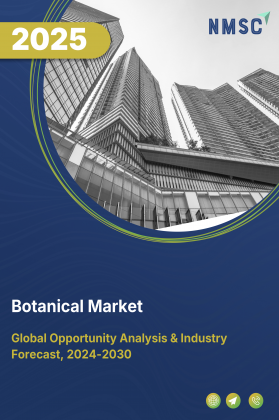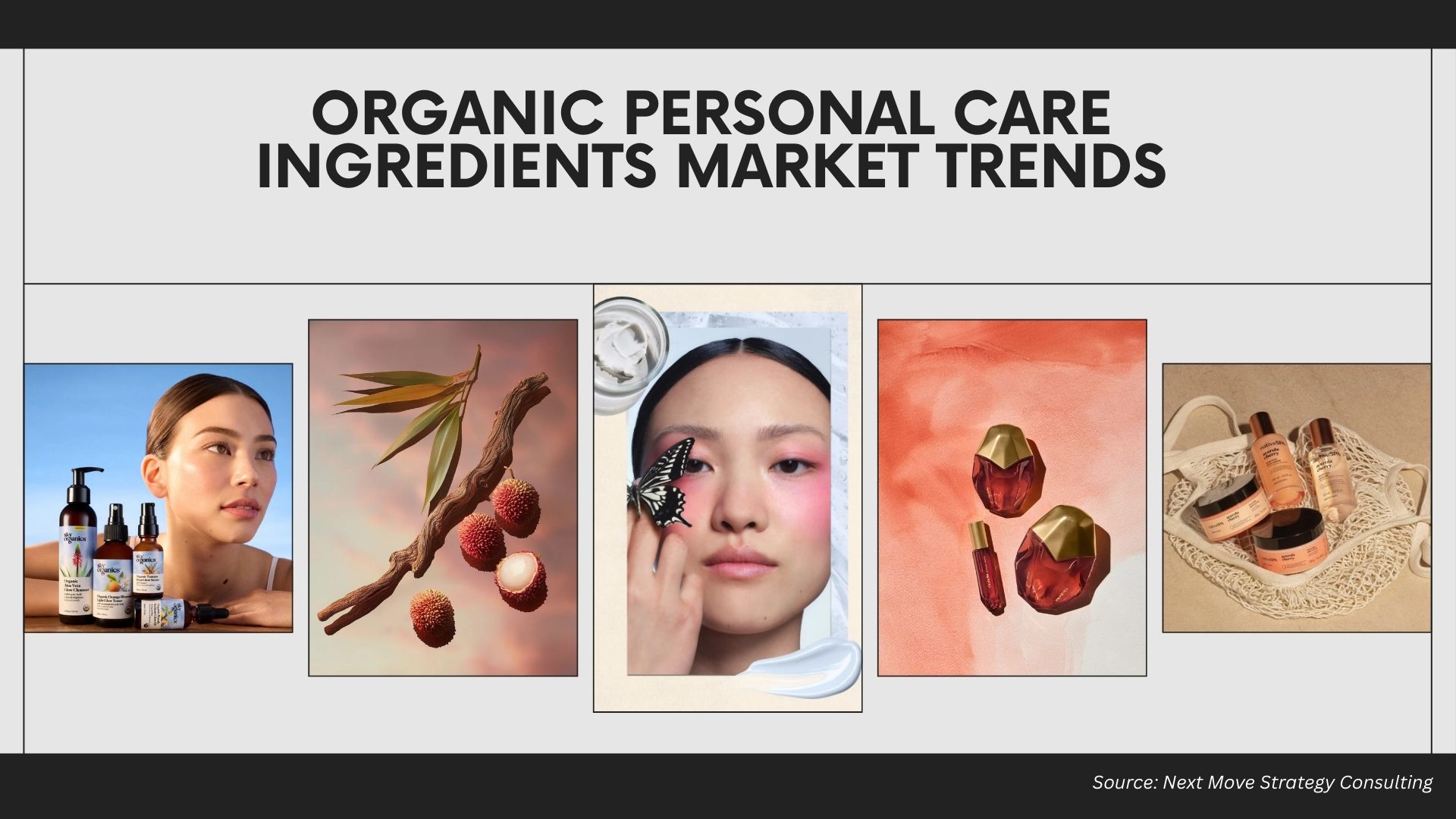
Botanical Market By Source (Herbs, Spices, Maltitol, Flowers, Leaves, Roots, Fruits, and Others), By Form (Fresh, Dried, Powder, Liquid, and Extracts), By Product Type (Botanical Extracts, Essential Oils, Herbal Powders, Herbal Teas, and Others), By Distribution Channel (Online Retail, Supermarkets and hypermarkets, and Others), By Application (Pharmaceuticals, Food & Beverages, Dietary Supplements, and Others) – Global Analysis & Forecast, 2025–2030
Industry Outlook
The global Botanical Market size was valued at USD 80.79 billion in 2024 and is expected to reach USD 86.64 billion by 2025. Looking ahead, the industry is projected to expand significantly, reaching USD 122.89 billion by 2030, registering a CAGR of 7.24% from 2025 to 2030.
The botanical market is experiencing significant growth, driven by increasing consumer demand for natural and plant-based products. This surge is evident across various sectors, including food and beverages, pharmaceuticals, personal care, and cosmetics. Consumers' preference for clean-label products, transparency in sourcing, and the perceived health benefits of botanicals are key factors contributing to this trend. The market encompasses a wide range of botanical ingredients, such as herbs, spices, flowers, and roots, which are utilized in diverse applications to meet the evolving needs of health-conscious individuals.
Looking ahead, the botanical market is poised for continued expansion, with projections indicating substantial growth over the coming years. Advancements in extraction technologies, coupled with a growing emphasis on sustainability and ethical sourcing, are expected to further propel the industry. As consumers increasingly seek holistic wellness solutions, the demand for botanical-based products is anticipated to rise, presenting opportunities for innovation and development of new applications. The industry's future prospects are promising, with the potential for botanicals to play a central role in shaping the future of natural and sustainable consumer goods.
Also, the growth of the urban population significantly drives market expansion by concentrating large, diverse groups of consumers in areas with advanced infrastructure, higher purchasing power, and greater exposure to new products and services, including botanicals. Urban environments foster increased demand for convenience, innovation, and lifestyle products, supported by digital platforms and efficient distribution networks, while trends such as rising disposable incomes, fast-paced lifestyles, and the proliferation of e-commerce further amplify the consumption of botanical products.
What are the Key Botanical Industry Trends?
How is the Botanical Market Embracing Functional Ingredients?
The industry is increasingly integrating functional ingredients into its offerings, catering to the growing consumer demand for health-enhancing products. For instance, acerola juice, maitake mushrooms, and chlorella are gaining attention due to their functional health benefits. This trend reflects a shift towards botanicals that offer specific health benefits, such as immune support and anti-inflammatory properties. Companies capitalize on this by formulating products that highlight these functional benefits, thereby attracting health-conscious consumers. The incorporation of such ingredients not only meets consumer expectations but also differentiates products in a competitive market.
What Role Does E-Commerce Play in the Botanical Market Growth?
E-commerce is significantly influencing the growth trajectory of the botanical market, providing consumers with convenient access to a wide range of shrubs and trees. The expansion of online platforms has improved accessibility, further boosting market growth globally. This digital shift is particularly evident in the botanical supplements sector, where online distribution channels are expected to grow at a lucrative CAGR. Companies are investing in robust online platforms and digital marketing strategies to reach a broader audience. Offering detailed product information, user reviews, and personalized recommendations further enhances customer experience and drive sales.
The chart depicts the share of the global e-commerce market by country in 2025, showing a highly concentrated landscape where China dominates with 52.1% of the market, followed by the USA at 20.1%, and other individual countries such as the UK, Japan, and South Korea holding much smaller shares. This overwhelming dominance by China and the USA suggests that the growth trajectory of the botanical market, which relies increasingly on digital retail channels for consumer reach and product visibility, will be significantly influenced by trends, regulations, and consumer preferences within these two economies.
How are Botanical Extracts Transforming the Personal Care Industry?
Botanical extracts are redefining personal care by providing natural alternatives to synthetic ingredients, responding to consumer demand for clean, transparent formulations. Ingredients such as herbal oils, flower extracts, and plant-based antioxidants are increasingly incorporated into skincare, haircare, and cosmetic products for their perceived health and beauty benefits. This trend reflects a broader consumer shift toward products that combine efficacy with sustainability and ethical sourcing. Companies capitalize on this by highlighting the origin, quality, and multifunctional properties of their botanical extracts, creating premium offerings that resonate with conscious consumers. Positioning products as naturally effective while maintaining transparency in formulation further strengthen brand credibility, encourage loyalty, and expand market share in the competitive personal care sector.
What are the Key Market Drivers, Breakthroughs, and Investment Opportunities that will Shape the Industry in the Next Decade?
The botanical market demand is experiencing dynamic growth, propelled by increasing consumer demand for natural, plant-based products across various sectors, including food, beverages, pharmaceuticals, and personal care. This surge is driven by a collective shift toward health-conscious and sustainable lifestyles, where transparency in sourcing and clean-label formulations is highly valued. As consumers become more informed about the benefits of botanicals, companies are innovating to meet these expectations, leading to a diverse range of applications and product offerings.
However, issues such as regulatory complexities, quality control, and the need for sustainable sourcing practices pose significant hurdles. Despite these challenges, opportunities abound for companies that navigate these complexities effectively. By focusing on innovation, ethical sourcing, and transparency, businesses capitalize on the growing interest in botanical products, positioning themselves for long-term success in this evolving market landscape.
Growth Drivers:
How is the Growing Consumer Preference for Natural Ingredients Driving the Industry?
The increasing consumer demand for natural and plant-based ingredients is significantly propelling the botanical market. As consumers become more health-conscious and environmentally aware, they are favouring products that align with their values, such as those with clean labels and natural origins. This shift is evident across various sectors, including food, beverages, pharmaceuticals, and personal care, where botanical ingredients are being incorporated to meet consumer demand for transparency and sustainability. The Indian government's support for the AYUSH sector, including initiatives to promote exports and international cooperation, further bolsters this trend. Companies capitalize on this by clearly communicating the benefits and origins of their botanical offerings, thereby building trust and loyalty among consumers.
What Technological Advancements are Enhancing the Cultivation and Processing of Botanical Ingredients?
Advancements in technology are playing a pivotal role in enhancing the cultivation and processing of houseplant ingredients. Innovations such as controlled environment agriculture, hydroponics, and vertical farming are revolutionizing the way botanicals are grown, allowing for more efficient production and consistent quality. Additionally, advancements in extraction technologies are improving the efficacy and purity of botanical extracts, making them more appealing for use in various applications. Companies leverage these advancements to improve product quality, reduce costs, and meet the growing global demand for botanical ingredients.
Growth Inhibitors:
What Regulatory Challenges are Hindering the Botanical Market Expansion?
Regulatory complexity remains a key inhibitor for the botanical market, with inconsistent rules across regions affecting product approvals, labelling, and international trade. Navigating these differing frameworks increase operational costs and extend time-to-market, particularly for companies aiming to expand internationally. The absence of uniform standards creates uncertainty in product development, forcing firms to invest in compliance and quality assurance. Companies therefore develop strong regulatory strategies, maintain high documentation standards, and proactively monitor policy changes that mitigate risks, ensuring smoother market entry and fostering consumer trust while maintaining product integrity.
How Can Companies Capitalize on the Rising Demand for Botanical-Based Functional Beverages?
The growing interest in botanical-based functional beverages presents a substantial opportunity for companies to innovate and diversify product portfolios. Consumers increasingly seek beverages that provide added health benefits such as digestive support, immunity enhancement, or stress relief. Botanical ingredients such as ginger, turmeric, and hibiscus are being widely incorporated for their functional properties and natural appeal. Companies capitalize on this trend by developing new formulations that combine efficacy with taste, emphasizing product transparency and health benefits in marketing, and exploring partnerships with beverage producers to expand distribution. Focusing on innovation and consumer engagement helps brands capture market share in this fast-growing segment.
How Botanical Market Share is Segmented in this Report, And What are the Key Insights from the Segmentation Analysis?
By Source Insights
Is the Botanical Industry in 2025 Shaped by Diverse Plant Sources?
Based on source, the market is segmented into herbs, spices, flowers, leaves, roots, fruits, and others.
Herbs, typically non-woody plants, are integral to the botanical market, especially in the United States. Common herbs like turmeric, ginger, and peppermint are widely used for their therapeutic properties and flavor profiles. Their versatility in various forms, such as capsules, teas, and extracts demonstrates their significant role in the market. Companies capitalize on this trend by developing innovative herbal products that align with consumer health and wellness preferences.
Spices, derived from various plant parts including seeds, roots, and bark, are essential in the botanical market for their flavor-enhancing and preservative qualities. Spices like cinnamon, cloves, and black pepper are not only culinary staples but also valued for their medicinal properties. Their inclusion in functional foods and supplements is increasing, driven by consumer interest in natural health solutions. Manufacturers explore the inclusion of spices in product formulations to meet the growing demand for functional and flavourful options.
Flowers, often underutilized, are gaining prominence in the industry for their aesthetic and therapeutic benefits. The USDA's definition of specialty crops includes floriculture, indicating the recognized value of flowers in various industries. Flowers like chamomile, lavender, and hibiscus are prized for their calming effects and are commonly used in teas, skincare products, and aromatherapy. Their appeal lies in their natural beauty and the perception of purity and wellness they convey. Brands leverage floral ingredients to enhance product offerings and attract consumers seeking natural and soothing experiences
By Form Insights
Is the Botanical Market in 2025 Being Shaped by Product Form?
On the basis of form, the market is segmented into fresh, dried, powder, liquid, and extract.
Fresh botanicals are valued for their natural flavor, aroma, and high nutrient content. Fresh forms are widely used in culinary applications, teas, and juices, offering superior sensory appeal compared to processed forms. Companies focusing on fresh botanicals differentiate through local sourcing, rapid distribution, and marketing the freshness and quality of their products. Dried botanicals are popular due to their extended shelf life and convenience in storage and transport. Drying preserves key bioactive compounds while allowing botanicals to be used in teas, spice blends, and nutraceuticals. Companies capitalize on dried botanicals by offering versatile and long-lasting products that appeal to consumers seeking convenience without compromising efficacy.
Powdered botanicals are created by grinding dried plant parts into fine particles, offering concentrated flavors and bioactive compounds. This form is widely used in dietary supplements, functional foods, and beverages. On the other hand, liquid botanicals, including oils, tinctures, and infusions, are preferred for their convenience and ease of incorporation into beverages, skincare, and supplements. Liquid forms facilitate rapid absorption of bioactive compounds and consistent dosing.
By Product Type Insights
How Are Product Type Driving the Botanical Industry in 2025?
On the basis of product type, the market is segmented into botanical extracts, essential oils, herbal powders, herbal teas, and others.
Botanical extracts are highly concentrated and rich in bioactive compounds, making them ideal for use in supplements, functional foods, and personal care products. They are favored for their stability, consistency, and ability to provide targeted health benefits. This segment dominates the market, driven by manufacturers’ preference for formulations that require precise dosing and potent effects. Essential oils are widely used for aromatherapy, personal care, and wellness applications due to their aromatic and therapeutic properties. Popular oils include lavender, peppermint, and tea tree, valued for relaxation, antimicrobial, and skincare benefits. While not as dominant as extracts, essential oils are experiencing steady growth as consumers increasingly seek natural alternatives to synthetic fragrances and chemicals in wellness and cosmetic products.
Herbal powders are derived from dried plant parts and provide concentrated flavors and bioactive compounds for teas, capsules, and functional foods. Their convenience, versatility, and ease of incorporation into formulations make them a popular choice in dietary supplements and food products. While they occupy a significant niche, they are less dominant than extracts due to variability in potency and sensory appeal. Herbal teas are consumed for their soothing effects, flavors, and perceived health benefits. Popular varieties include chamomile, hibiscus, and peppermint. This segment is growing steadily as consumers adopt herbal teas for relaxation, digestive support, and general wellness.
By Distribution Channel Insights
Are Distribution Channels Shaping the Botanical Market in 2025?
On the basis of distribution channel, the market is segmented into online retail, supermarkets and hypermarkets, specialty stores and salons, direct sales.
Online retail is emerging as the dominant distribution channel for botanical products, offering convenience, broad product variety, and easy comparison of features and prices. E-commerce platforms allow consumers to access rare and specialty botanicals that may not be available locally. Brands leverage online channels to provide detailed product descriptions, usage guidance, and subscription models, enhancing customer engagement and loyalty.
Supermarkets and hypermarkets remain important channels, particularly for everyday herbal teas, powders, and dried botanicals. These channels provide wide accessibility and bulk purchasing options, appealing to mainstream consumers. While less dominant than online retail in niche or high-value segments, they are critical for mass-market penetration and brand visibility.
By Application Insights
Which Applications Are Driving the Botanical Market Trends in 2025?
On the basis of application, the market is segmented into pharmaceuticals, food & beverages, dietary supplements, personal care & cosmetics, animal feed & pet care, and others.
Botanicals are widely used in pharmaceuticals for their therapeutic properties, including anti-inflammatory, antioxidant, and immune-support effects. They are incorporated into prescription and over-the-counter products as active ingredients or complementary therapies. The pharmaceutical application dominates the market because of the demand for natural alternatives and the proven efficacy of plant-derived compounds in managing health conditions.
In the food and beverage industry, botanicals are used for flavoring, coloring, and functional benefits. Ingredients such as herbs, spices, and fruit extracts enhance both taste and nutritional value. This segment is growing steadily as consumers increasingly seek clean-label and functional products, such as herbal teas, fortified beverages, and plant-based snacks.
Dietary supplements represent a major application of botanicals, providing concentrated doses of vitamins, minerals, and bioactive plant compounds. Popular forms include capsules, powders, and liquid extracts designed to support immunity, digestion, and overall wellness. This segment is highly influential in driving market growth due to consumer demand for preventive health and functional nutrition.
Regional Outlook
The botanical market is geographically studied across North America, Europe, Asia Pacific, Middle East & Africa, and Latin America and each region is further studied across countries.
Botanical Market in North America
North America stands as a significant player in the global botanicals market, driven by a robust inclination towards natural and plant-derived products. This growth is propelled by increasing consumer awareness of health and wellness, leading to a surge in demand for botanical supplements and natural ingredients in personal care. The prevalence of chronic diseases and an aging population further contribute to the market's expansion. Additionally, the growing preference for clean-label products and sustainable sourcing practices aligns with the region's regulatory standards, fostering innovation and market development.
Botanical Market in the United States
In the United States, the botanicals market is experiencing significant growth, driven by the rising consumer demand for natural and organic products. This trend is evident in the increasing popularity of herbal supplements, functional foods, and natural cosmetics. The U.S. market's expansion is also supported by favorable regulatory frameworks and a well-established distribution network, facilitating the widespread availability of botanical products. Moreover, ongoing research and development efforts are enhancing the efficacy and safety profiles of botanical ingredients, further boosting consumer confidence and market adoption.
Botanical Market in Canada
Canada's botanicals market is characterized by a strong consumer preference for plant-based and sustainable products. This preference is reflected in the growing demand for herbal supplements, natural skincare products, and functional foods. The Canadian market benefits from stringent regulatory standards that ensure product quality and safety, fostering consumer trust. Additionally, the increasing awareness of the health benefits associated with botanical ingredients is driving market growth, positioning Canada as a key player in the North American botanicals sector.
Botanical Market in Europe
Europe exhibits steady growth in the botanicals market, underpinned by stringent quality standards and a strong consumer inclination towards natural products. The European market's expansion is facilitated by the EU's Farm to Fork Strategy and Green Deal, which promote sustainable sourcing of botanicals. Countries like Germany, France, and the UK are at the forefront of integrating botanical extracts into pharmaceuticals, nutraceuticals, and cosmetics, driven by consumer demand for clean-label and plant-based products. This regulatory support and consumer preference for sustainability are pivotal in shaping Europe's botanical market landscape.
Botanical Market in the United Kingdom
The United Kingdom's botanicals market is experiencing growth, fueled by increasing consumer awareness of the benefits of natural ingredients. The UK's market is characterized by a strong demand for herbal supplements and natural skincare products. This demand is supported by favorable regulatory frameworks and a well-established distribution network, ensuring the availability of high-quality botanical products. Additionally, the rising popularity of clean-label products and sustainable sourcing practices aligns with consumer preferences, driving market expansion in the UK.
Botanical Market in Germany
The country's established pharmaceutical and nutraceutical industries are integrating high-quality botanical extracts into product formulations. Stringent regulations and quality assurance standards are shaping demand for standardized and certified extracts, ensuring product efficacy and safety. This regulatory environment, coupled with consumer preference for natural products, positions Germany as a leader in the European botanicals market.
Botanical Market in France
France's botanicals market is experiencing growth, driven by a strong consumer preference for natural and organic products. The French market is characterized by increasing demand for herbal supplements, functional foods, and natural cosmetics. This demand is supported by stringent regulatory standards that ensure product quality and safety. Additionally, the rising awareness of the health benefits associated with botanical ingredients is fueling market expansion, positioning France as a significant player in the European botanicals sector.
Botanical Market in Italy
Italy's botanicals market is characterized by a growing consumer inclination towards natural and plant-derived products. This trend is evident in the increasing popularity of herbal supplements, functional foods, and natural skincare products. The Italian market benefits from a rich tradition of herbal medicine and a strong emphasis on quality and authenticity, fostering consumer trust. Additionally, the integration of botanical ingredients into traditional Italian cuisine and wellness practices further drives market growth, highlighting Italy's unique position in the European botanicals landscape.
Botanical Market in Spain
Spain's botanicals market is experiencing steady growth, driven by a rising consumer preference for natural and organic products. The Spanish market is characterized by increasing demand for herbal supplements, functional foods, and natural cosmetics. This demand is supported by favorable regulatory frameworks and a well-established distribution network, ensuring the availability of high-quality botanical products. Additionally, the growing awareness of the health benefits associated with botanical ingredients is contributing to market expansion in Spain.
Botanical Market in the Nordics
The Nordic countries, including Sweden, Denmark, Norway, and Finland, exhibit a strong preference for sustainable and natural products, driving the growth of the botanicals market demand. Consumer demand for herbal supplements, natural skincare products, and functional foods is on the rise, supported by stringent regulatory standards that ensure product quality and safety. The Nordic market's emphasis on environmental sustainability and ethical sourcing aligns with the increasing consumer awareness of the health benefits associated with botanical ingredients, fostering market expansion in the region.
Botanical Market in the Asia-Pacific
Asia-Pacific is both the largest supplier and the fastest-growing consumer market for botanicals, driven by rising disposable incomes and increasing consumer awareness of the health benefits of botanical ingredients. India dominates production of ashwagandha and turmeric, while China leads in ginseng cultivation. Rising middle-class demand in markets like South Korea and Indonesia is driving regional consumption growth. This growth is further supported by traditional medicine practices and a shift towards natural and plant-based products.
Botanical Market in China
China's botanicals market is experiencing significant growth, driven by the country's rich history of traditional medicine and increasing consumer demand for natural and plant-derived products. The market is characterized by a rising preference for herbal supplements, functional foods, and natural cosmetics. This demand is supported by favorable regulatory frameworks and a well-established distribution network, ensuring the availability of high-quality botanical products. Additionally, ongoing research and development efforts are enhancing the efficacy and safety profiles of botanical ingredients, further boosting consumer confidence and market adoption in China.
Botanical Market in Japan
Japan's botanicals market is characterized by a strong consumer preference for natural and functional products. The Japanese market exhibits increasing demand for herbal supplements, functional foods, and natural skincare products. This demand is driven by the aging population and a growing awareness of the health benefits associated with botanical ingredients. The Japanese market's emphasis on quality and innovation, coupled with stringent regulatory standards, ensures the availability of safe and effective botanical products, fostering market growth.
Botanical Market in India
India's botanicals market is experiencing rapid growth, driven by the country's rich heritage of traditional medicine and increasing consumer awareness of the health benefits of botanical ingredients. The market is characterized by rising demand for herbal supplements, functional foods, and natural cosmetics. This growth is supported by favorable regulatory frameworks and a well-established distribution network, facilitating the widespread availability of botanical products. Additionally, India's dominance in the production of key botanicals, such as ashwagandha and turmeric, positions the country as a significant player in the global botanicals market.
Botanical Market in South Korea
South Korea's botanicals market is experiencing significant growth, driven by the country's increasing consumer demand for natural and plant-derived products. The market is characterized by rising popularity of herbal supplements, functional foods, and natural cosmetics. This demand is supported by a well-established distribution network and favourable regulatory frameworks, ensuring the availability of high-quality botanical products. Additionally, the growing awareness of the health benefits associated with botanical ingredients is contributing to market expansion in South Korea.
Botanical Market in Taiwan
Taiwan's botanicals market is characterized by a strong consumer preference for natural and functional products. The Taiwanese market exhibits increasing demand for herbal supplements, functional foods, and natural skincare products. This demand is driven by the aging population and a growing awareness of the health benefits associated with botanical ingredients. The Taiwanese market's emphasis on quality and innovation, coupled with stringent regulatory standards, ensures the availability of safe and effective botanical products, fostering market growth.
Botanical Market in Indonesia
Indonesia's botanicals market is experiencing growth, driven by the country's rich biodiversity and increasing consumer awareness of the health benefits of botanical ingredients. The market is characterized by rising demand for herbal supplements, functional foods, and natural cosmetics. This growth is supported by favorable regulatory frameworks and a well-established distribution network, facilitating the widespread availability of botanical products. Additionally, Indonesia's position as a key supplier of various botanicals contributes to its significance in the global botanicals market.
Botanical Market in Australia
Australia's botanicals market is poised for significant growth, driven by several key factors. The increasing consumer preference for natural and plant-based products is evident, with a rising demand for herbal supplements, functional foods, and natural cosmetics. This trend is supported by the country's rich biodiversity and the availability of unique native botanicals. For instance, the Jurlique Rose, cultivated in the Adelaide Hills, is renowned for its skin moisture retention properties and is central to Jurlique's skincare range. Additionally, Australia's strong regulatory frameworks ensure product quality and safety, fostering consumer trust and market expansion.
Botanical Market in Latin America
In Latin America, the botanicals market is experiencing growth, fueled by the region's rich cultural heritage and traditional use of plant-based remedies. Countries like Brazil and Mexico are witnessing increased demand for herbal supplements and natural cosmetics, driven by consumer awareness of the health benefits associated with botanical ingredients. The market's expansion is also supported by favorable climatic conditions conducive to the cultivation of various botanicals. However, challenges such as inconsistent regulatory standards and supply chain complexities need to be addressed to sustain growth.
Botanical Market in the Middle East & Africa
The Middle East & Africa region presents a diverse landscape for the botanicals market, with varying growth patterns across countries. In the Middle East, there is a growing demand for herbal supplements and natural cosmetics, influenced by traditional medicine practices and increasing consumer awareness of health and wellness. In Africa, countries like South Africa are witnessing a rise in the use of botanical ingredients in pharmaceuticals and personal care products, driven by the need for affordable and accessible health solutions. The region's rich biodiversity offers opportunities for the development of unique botanical products, although challenges related to infrastructure and regulatory frameworks need to be addressed.
Competitive Landscape
Which Companies Dominate the Botanical Industry and How Do They Compete?
Leading companies in the botanical market, such as Givaudan SA, Symrise AG, International Flavors & Fragrances Inc. (IFF), and Firmenich, have established themselves as key players through strategic acquisitions and global expansion. Givaudan, for instance, has a strong presence in the botanical sector, leveraging its extensive research and development capabilities to create innovative plant-based products. Symrise AG focuses on sustainable sourcing and has invested in expanding its botanical portfolio to meet the growing demand for natural ingredients. IFF, with its global reach, emphasizes the integration of botanical ingredients into its flavor and fragrance offerings, catering to diverse consumer preferences. These companies compete by differentiating their product offerings, investing in sustainability, and expanding their global footprints to capture market share.
Market Dominated by Botanical Giants and Specialists
The botanical market is characterized by a blend of global giants and specialized firms, each carving out niches across various regions and product categories. Companies like Givaudan and IFF dominate the global landscape with their extensive portfolios and research capabilities. In contrast, specialists such as Indena S.p.A. and Arjuna Natural Extracts Ltd. focus on specific botanical ingredients, offering expertise and high-quality products tailored to particular applications. This dual structure fosters healthy competition, with large firms leveraging scale and innovation, while specialists drive advancements in specific botanical segments. The competition is further intensified by regional players who understand local consumer preferences and regulatory landscapes, allowing them to offer customized solutions and gain competitive advantages in their respective markets.
Innovation and Adaptability Drive Market Success
Innovation is a key driver of success in the botanical market, with companies continually developing new products and applications to meet evolving consumer demands. Givaudan, for example, has invested in sustainable sourcing and advanced extraction technologies to enhance the quality and efficacy of its botanical ingredients. Symrise AG focuses on integrating biotechnology into its production processes, enabling the creation of novel botanical derivatives with enhanced functionalities. Similarly, IFF emphasizes the development of plant-based solutions that align with consumer trends towards natural and clean-label products. These companies' commitment to innovation ensures they remain competitive and responsive to market changes, positioning them for long-term success in the dynamic botanical sector.
Market Players to Opt for Merger & Acquisition Strategies to Expand Their Presence
Merger and acquisition (M&A) strategies have become pivotal for companies aiming to strengthen their position in the botanical market. In 2024 and 2025, key transactions exemplify this trend. In October 2025, Martin Bauer Group GmbH acquired American Botanicals, a leading U.S. wildcrafted botanicals supplier, enhancing its agricultural footprint and ability to serve the global food and dietary supplement industries. Similarly, in November 2024, India-based OmniActive Health Technologies acquired Enovate Biolife to expand its portfolio of clinically validated botanical ingredients and strengthen its international presence. These strategic moves reflect a broader industry trend of consolidation, enabling companies to leverage synergies, accelerate innovation, and meet the rising global demand for natural and sustainable botanical products.
List of Key Botanical Companies
-
International Flavors & Fragrances Inc. (IFF)
-
Kerry Group plc
-
Indena S.p.A.
-
Martin Bauer Group GmbH
-
Robertet Groupe
-
Kalsec Inc.
-
EUROMED S.A.
-
Arjuna Natural Extracts Ltd.
-
Mane Kancor
-
Tsumura & Co., Ltd.
-
Synthite Industries Pvt. Ltd.
-
Finzelberg GmbH & Co. KG
-
Horphag Research
What are the Latest Key Industry Developments?
-
October 2025- MartinBauer Group GmbH expanded its U.S. agricultural footprint by acquiring American Botanicals, a leading supplier of wildcrafted botanicals. This acquisition enhances MartinBauer's ability to deliver sustainable, high-quality botanicals to the global food and dietary supplement industries.
-
May 2025- Roquette, a global leader in plant-based ingredients, completed the acquisition of IFF Pharma Solutions. This strategic move reinforces Roquette's position as a major partner in the global pharmaceutical market, expanding its capabilities in pharmaceutical excipients.
-
December 2024- Symrise announced a public offer to acquire a majority stake in Probi AB, a Swedish biotics company. This acquisition enhances Symrise's portfolio in health-focused ingredients, aligning with the growing demand for functional foods and supplements.
-
November 2024- OmniActive Health Technologies acquired ENovate Biolife, a developer of botanical ingredients. This strategic move strengthens OmniActive's commitment to innovative, clinically proven health ingredients for consumer products, particularly in the dietary supplement space.
-
July 2024- Givaudan, a global leader in Fragrance and Beauty, completed the acquisition of b.kolormakeup & skincare, an Italian company specializing in developing and producing finished makeup and skincare products. This acquisition expands Givaudan's capabilities in the beauty sector.
What are the Key Factors Influencing Investment Analysis & Opportunities in the Botanical Market?
Investment in the industry is increasingly shaped by the rising global demand for natural, sustainable, and functional products. Investors are attracted to companies that focus on high-value botanical extracts, innovative formulations, and plant-based solutions across pharmaceuticals, dietary supplements, and personal care. Funding trends show a preference for businesses that emphasize quality, traceability, and regulatory compliance, as these factors reduce risk and enhance long-term growth potential.
Valuations in the botanical sector are influenced by product differentiation, intellectual property related to unique botanical formulations, and the ability to scale production efficiently. Investment hotspots are emerging in regions with strong biodiversity and established production infrastructure, such as Asia-Pacific and parts of North America and Europe. Companies that integrate sustainability, ethical sourcing, and innovative delivery formats attract higher investor interest, while strategic partnerships and R&D collaborations further enhance opportunities in this rapidly evolving market.
Key Benefits for Stakeholders:
Next Move Strategy Consulting (NMSC) presents a comprehensive analysis of the botanical market, covering historical trends from 2020 through 2024 and offering detailed forecasts through 2030. Our study examines the market at regional and country levels, providing quantitative projections and insights into key growth drivers, challenges, and investment opportunities across all major botanical segments.
The botanical industry offers distinct benefits to various stakeholders by aligning economic value with health and wellness trends. Investors gain from strong growth potential, diversification opportunities, and the chance to back companies with innovative, high-margin plant-based products. Customers benefit through access to natural, functional, and sustainable solutions that support overall health, beauty, and nutrition, meeting the rising demand for clean-label and safe ingredients. Additionally, suppliers and producers enjoy steady demand for raw materials, while manufacturers leverage botanicals to create differentiated, premium products. This ecosystem fosters mutual growth, where innovation, quality, and sustainability drive value for both financial stakeholders and end consumers.
Report Scope:
|
Parameters |
Details |
|
Market Size in 2025 |
USD 86.64 Billion |
|
Revenue Forecast in 2030 |
USD 122.89 Billion |
|
Growth Rate |
CAGR of 7.24% from 2025 to 2030 |
|
Analysis Period |
2024–2030 |
|
Base Year Considered |
2024 |
|
Forecast Period |
2025–2030 |
|
Market Size Estimation |
Billion (USD) |
|
Growth Factors |
|
|
Companies Profiled |
15 |
|
Countries Covered |
33 |
|
Market Share |
Available for 10 companies |
|
Customization Scope |
Free customization (equivalent to up to 80 analyst-working hours) after purchase. Addition or alteration to country, regional & segment scope. |
|
Pricing and Purchase Options |
Avail customized purchase options to meet your exact research needs. |
|
Approach |
In-depth primary and secondary research; proprietary databases; rigorous quality control and validation measures. |
|
Analytical Tools |
Porter's Five Forces, SWOT, value chain, and Harvey ball analysis to assess competitive intensity, stakeholder roles, and relative impact of key factors. |
Key Market Segments
By Source
-
Herbs
-
Spices
-
Flowers
-
Leaves
-
Roots
-
Fruits
-
Others
By Form
-
Fresh
-
Dried
-
Powder
-
Liquid
-
Extracts
By Product Type
-
Botanical Extracts
-
Standardized extracts
-
Non-standardized extracts
-
-
Essential Oils
-
Single oils
-
Blended oils
-
-
Herbal Powders
-
Single herb powders
-
Blended herb powders
-
-
Herbal Teas
-
Loose leaf teas
-
Tea bags
-
-
Others
By Distribution Channel
-
Online Retail
-
Supermarkets and hypermarkets
-
Specialty stores and salons
-
Direct Sales
By Application
-
Pharmaceuticals
-
Over-the-counter medicines
-
Prescription drugs
-
-
Food & Beverages
-
Functional foods
-
Beverages (e.g., herbal teas, flavoured drinks)
-
Sauces and dressings
-
Bakery and confectionery
-
-
Dietary Supplements
-
Tablets
-
Capsules
-
Soft gels
-
Powders
-
Gummies
-
Liquids
-
-
Personal Care & Cosmetics
-
Skincare products
-
Haircare products
-
Fragrances
-
-
Animal Feed & Pet Care
-
Nutritional supplements for animals
-
Pet food additives
-
-
Other Applications
-
Household products
-
Agricultural applications
-
Geographical Breakdown
-
North America: U.S., Canada, and Mexico.
-
Europe: U.K., Germany, France, Italy, Spain, Sweden, Denmark, Finland, Netherlands, and rest of Europe.
-
Asia Pacific: China, India, Japan, South Korea, Taiwan, Indonesia, Vietnam, Australia, Philippines, Malaysia and rest of APAC.
-
Middle East & Africa (MEA): Saudi Arabia, UAE, Egypt, Israel, Turkey, Nigeria, South Africa, and rest of MEA.
-
Latin America: Brazil, Argentina, Chile, Colombia, and rest of LATAM
Conclusion & Recommendations
Our report equips stakeholders, industry participants, investors, and consultants with actionable intelligence to capitalize on Botanical’s transformative potential. By combining robust data-driven analysis with strategic frameworks, NMSC’s botanical market report serves as an indispensable resource for navigating the evolving landscape. The industry is poised for sustained growth, driven by increasing consumer preference for natural, functional, and sustainable products across multiple industries. Strategic takeaways highlight the importance of product innovation, regulatory compliance, and supply chain transparency, as these factors enhance brand credibility and market competitiveness. Companies that focus on high-value botanical extracts, novel formulations, and diversified applications capture larger market shares and strengthen long-term growth prospects. The integration of sustainability and ethical sourcing further positions firms to meet evolving consumer expectations while differentiating themselves in a crowded marketplace.
For executives and investors, the key to capitalizing on these trends lies in identifying high-potential segments, investing in R&D for innovative botanical solutions, and fostering strategic partnerships to expand market reach. Prioritizing regions with abundant biodiversity and favorable regulatory frameworks optimize production and sourcing strategies. Additionally, emphasizing consumer education, transparent labeling, and premium product positioning enhance brand trust and accelerate adoption, unlocking significant opportunities for value creation in the botanical market.




















 Speak to Our Analyst
Speak to Our Analyst

























